The first time they raised her she said, ‘Behold, I see my father and mother.’
The second time she said, ‘I see all my dead relatives seated.’
The third time she said, ‘I see my master seated in Paradise and Paradise is beautiful and green; with him are men and boy servants. He calls me. Take me to him.’
That’s right folks, we’re going to do an introductory article for a 5 year old historical miniature game. Here at Corehammer, we like to be only the most current and cutting edge with our content. Stay tuned for our Warhammer “The End Times” thoughts and possibly some rumors on a shadowy new edition of the game with talk of controversial round bases. Maybe a quick review of the first Avengers movie and bitching about Tom Hardy’s Bane while I’m at it. Also, did you know women can vote now? Topical. So why am I actually spending time introducing Saga? It started with a simple WhatsApp message from the frozen Nordic lands, “Did I hear you played Saga?” I gave some quick thoughts, praise and warnings back and went on about my day. But something about that little conversation stuck with me. I started thinking about the game again, how more people should be playing it, how it is such an interesting introduction to the historical miniature hobby, and how dammit, I want to be playing again. Some weeks pass and the fad light has been switched on (not by me) and my friends group were all looking to dive in for some sweet, sweet, Saga gaming. I quickly realized there is still a lot of information out there that is either missing, or hard to find, and is relevant for someone looking to get into the game. This means that even though the game was released a little while back, and was reasonably popular for a niche wargame, there is enough of a gap out there that makes it worth my frankly pretty worthless time to write up an intro. This first article will focus on the original Viking Age flavor of the game, a part 2 with shopping and figure recommendations and a follow up to cover those Mediterranean romps in the sun from Crescent and Cross. This ultimately will be my utterly cack-handed attempt at opening the vault and sharing my nonsense ramblings on what really is a superb little game.
Experience
I’ve been playing Saga off and on since its release using a number of armies (primarily Pagan Rus, Princes Rus, Vikings and Jomsvikings). I had a number of early medieval figures painted up for Warhammer Historical games and boarded the hype train pretty damn early since I already had some stuff ready. I had been playing historical miniature games for a while and this one seemed to have a solid combination of smallish army size, interesting rules and a larger proportion of willing players than most rule sets. I have also had the pretty damn lucky chance to play in a couple extremely friendly and interesting tournaments that kept the fire in me burning, but the bulk of my gaming has been with friends up and down the west coast. Really I think I’m writing this article to hopefully influence a few more people out there to play, so that I might get some more games in. Pure desperation.
The Game
So what is Saga: Viking Age? At its core, Saga is a historical miniature skirmish game created by Studio Tomahawk and released by Gripping Beast pitting warbands from early medieval period against each other in a number of scenarios. It encompasses all your favorite hairy bearded thugs from roughly the year 793 AD to 1100 AD. Classics like Vikings, Anglo-Saxons and Normans are joined by all different varieties of Irish, Welsh, Bretons, Rus and even Byzantines who show up adding a distinctive southern continental flavor to proceedings. This isn’t a mass battle game, but instead focuses on armies of 30-60 figures, led by a single bad ass warlord, fighting out the kind of endemic small scale warfare the period would have been full of. This is exactly the type of fucking warfare I want to play for this period. Sure mass battle are neat, but when I think Vikings, I want raids on Christian monasteries, bloody skirmishes around a small farm or even just two rival tough guys brawling while all their friends grab weapons and get ready to go at it. Saga easily enables this type of characterful and narrative gameplay and really brings the flavor of this dark and violent time.
How does Saga actually play? Turns are handled in a simple “I go” then “you go” method with a player activating single units at a time (for the most part), completing their relevant actions and moving on to their next unit. Once you’ve used up all your activations, the turn passes to your opponent. The actual rules for moving, shooting, fighting and winning are, in the end, pretty damn simple. There are also very few classes of soldier to build your warband with, limited primarily to a warlord, hearthguard, warriors and levies. However, while there is simplicity in basic rules and troop types, incredible complexity is surfaced from the ‘Battle Boards’ of each faction. This is where almost all of the flavor and tactical variations comes from in Saga. The ‘Battle Board’ is a cardstock sheet where a player allocates specially rolled dice. These dice are “spent” on different abilities described on the ‘Battle Board’ each turn, including activating units. An ability might allow your unit to move further, fight better or even cancel an opponent’s move etc… This means each turn you have a randomly determined set of resources (the symbols on the dice you’ve rolled) and must tune your strategy constantly to make best use of what those resources can get you. You might have a devastating combination of abilities planned, but that leaves you short on activations and you also need to protect an endangered unit. This random resource management is one of the most alluring aspects of the game, but also adds a whole lot of complications.
To be clear, because of the ‘Battle Boards,’ and the complex interactions they create, Saga is not a simple game at all. The very clear steps and interactions from the main rules are constantly subverted, changed or just fucking ignored once you start throwing in board abilities. And the abilities themselves aren’t always the easiest to understand or implement in game. A substantial portion of each rulebook is devoted to commentary on what those abilities are, how they work and what actual benefits they serve. Once a few of these abilities start interacting on the battlefield, the thinking part of the game ramps up pretty fucking quickly. You see, complexity and strategic depth in a miniature wargame usually comes through in a few ways that can be categorized as A) maneuver elements and B) interactions C) actions (which we won’t cover). So Saga has actually very few maneuver elements in a standard game, being defined as figures or groups of figures that maneuver and act independently. In a starter 4 point game you might only have 3-5 elements (units). In a full 6 point game that only goes up to between 5-7 elements for each army. An 8th edition Warhammer army would generally include a few more (once you include units, war machines, characters etc…). A full Frostgrave warband could include 11-12 figures each with independent movement and actions. Chess as a more extreme example has 16 individual pieces that can each move and act independently. The other main source of complexity is interactions. Chess has only a very small number of interactions defined between pieces, although Chess does have incredible strategic depth with those relatively simple interactions. Saga has a shit ton of interactions. Most steps in the game can be influenced not just by abilities on your own “Battle Board,” but by your opponents as well. This makes it important to both understand and work through each of the specific steps in the turns and phases. If this paragraph scared you, fuck it, try the game. It is definitely crunchy, but I really think the games strategy and long term engagement is directly tied to this battle board based complexity. Seriously, give it a try.
Starting Out
If you’ve gotten this far, you might be thinking “this all sounds pretty sweet bro, but how do I start?” The first thing you need are rules and figures. Now the basic rules are contained in ‘SAGA Viking Age Skirmishes Rulebook’ along with details and ‘Battle Boards’ for the first 4 factions, Vikings, Welsh, Anglo Danes and Normans. The rest of the books contain primarily new factions and some small expansion rules, mercenaries and scenarios. What you generally need is the main rulebook, and the book relevant to your faction. That being said, you’ll probably eventually want all the books/battle boards and they’re not that expensive. You also need dice, regular D6’s for the game and special Saga dice for the battle board, these are different depending on which faction you are using. See the tips at the end for alternative Saga dice methods.
Choosing a Faction
Choosing your faction (or factions) is an entirely personal choice. I can offer basic guidance on methods you can use, but I’m never going to say “play this army” as my tastes, style and interests are always going to be a little different than yours. What I would advise however is to first think about what faction immediately speaks to you. Have you always had a love of crazy Norse warriors? Go with Vikings (or one of their variants). Bursting with Irish pride? Play them. Always wanted to paint the forces of William the Conqueror? Go with Normans. What you have an existing interest in, and want to spend the time collecting and painting is probably what is most important for picking that new army. Next I would consider the play style and difficulty of the faction. Studio Tomahawk has attempted to classify them all here speaking to each faction’s complexity. Don’t let a higher complexity scare you too much off a faction you really want to play though. If you’re the type of person that either enjoys a challenge, or is happy to suffer through some loses then feel free to dive into the tougher ones and just learn as you go. If however you are the type to get pissed and rage quit after a first bad loss, you might want to stick to the simpler factions to start and ease into things. You know your tendencies, let them guide you. Also, I’m going to let you in on a little secret, you can easily collect multiple armies in Saga using almost entirely the same figures, so when you initially pick a faction, you’re actually picking a whole host of options.
Getting the Most from Your Figures
Warriors in Northern Europe in the early medieval period all looked pretty damn close to each other. Now we, as fussy historical wargamers, love to assign different characteristics and appearances to soldiers of the past. This lets us collect more figures, create new rules and visually distinguish units and factions on the board. We want our Vikings to look totally different than our Saxons who look different than our Rus because that is fun. The truth however, is there was little practical difference in the arms and equipment, especially at the 28mm scale, of the factions presented in the book. Iconography could be different, and religion, but honestly so many Scandinavians in Britain and Ireland converted even that was fluid. Not to mention the fact that many warriors crossed what we consider the faction lines regularly. Honestly the primary differences between the factions are whether they wore pants, didn’t wear pants or mostly rode horses. Almost every faction in Viking Age Saga fits into one of those silos (seen in the image below) except for a few annoying outliers.
This means you can easily purchase the core of an army from one of those silos, and then change out a small part to make it work for another one of the armies. This shrinks that initial choice down and empowers you as a player to feel less worry about your faction selection. All of the “Pants” armies have a similar look for most of their warriors and hearthguard. These are all primarily Germanic and Scandinavian based cultures who are either invading Britain during the period (Vikings, Anglo Danes), previously invaded (Anglo Saxons), related closely in warrior culture to the invaders (Pagan Rus) or are just fighting everywhere looking like that (Jomsvikings). Anglo Saxons had a rather distinct hat that miniature manufacturers love to stick on them, so avoiding that, the rest is pretty agnostic. You can build an army useable as Vikings to start, decide you like Anglo Danes and add a few two handed axe men. Then you read about Jomsvikings and add a few more two handed axe men and you’re good to go.
This is true of the “No Pants” faction as well. Welsh, Irish, Norse Gaels and Scots would have little to no strong cultural distinguishing traits amongst their warriors at 28mm during this period. Sure Scots had more spearmen, and Welsh would have more folks with slightly shorter spears being used as javelins, but this isn’t something to be too fussy over. Start with a Welsh or Irish core army, then add axes to make Norse Gaels, or war dogs to make Irish. Essentially, generic early medieval warriors in Britain are just that, pretty fucking generic. If some button counting historical asshole is going to be a dick about things just point them my way and I’m happy to debate sources.
Shop, Shop, Shop
Start by purchasing and painting a solid core of figures that will be usable in most variations of your faction, and extend to other similar factions as detailed above. Also get a cool looking warlord. These dudes are tough as nails in the game so you want a suitably awesome figure. Starter size is 4 points for a warband, but you’ll quickly want to jump into 6 point games as well. For a 4 point army, you’ll usually want something like 2 pts of hearthguard (8 figures), 1 pt warriors (8 figures) and either another 1 pt of warriors (8 figures) or 1 pt of levy (12 figures). Some armies don’t even use levies and some players just hate on the poor guys even though they can be super useful. Your mileage with levies will vary.
Extending to 6 pts is easy, just add a few more hearthguard, warriors or levy as you feel works for you. Example shown in the diagram for a balanced looking early 6 point collection. Once you have that core, and can play games, you learn what you like using, and can chop and change as necessary. Then you can look at extending the core into more specialist troops that are only present in one faction (Dane axe armed folks, berserkers, fucking war dogs etc…). This will allow you to paint up a small force and then add faction specifics to quickly build up a number of armies. That way, as you read through the expansions, or get your ass handed to you by a fun looking army that is part of your silo (pants, no pants, horses), you could just paint up a handful of figures and get a few games in with an entire new army.
That’s it. If you like what you’ve heard try the game out. I’ve got a few more tips below and feel free to ask me questions in the comments or the Facebook group. I’ll be following this shortly with a Part 2 on sourcing miniatures for each of the factions and some further reading in the Viking Age.
General Tips
Battle Boards: Put your Battle Boards in a damn binder. Seriously, go out, get a 3 ring binder and some clear plastic pockets that fit the boards and put them in there. This will make things far easier to manage, protects them and makes them easier to read and reference when sitting on the toilet, where all true wargames reading is done.
Dice: If you’re lazy, or don’t mind spending the money, buy the official Saga dice. They’re pretty fucking cool. If you hate the idea of spending hard earned cash on overpriced dice, you have some options. Either A) Get blank dice, use transfers or stickers for the symbols and make (with a little effort) far cheaper Saga dice that do the job nicely or B) Use normal d6’s with pips or numbers…then modify your battle board to show the numbers needed instead of symbols. I would suggest using some kind of label placed over the relevant section of the ‘Battle Board’ that clearly shows the numbers you need. If your boards are in plastic pockets as suggested above, you can put it on the pocket, just make sure you label the pocket with the faction so these don’t get messed up. This is slightly sub optimal but works. I would strongly advise against just saying “6’s are this symbol and 4’s and 5’s are this” and trying to play without labeling your board as this gets crazy annoying pretty quickly. Full disclosure, I just bought the fucking dice cause I love merch.
Some alternate dice strategies can be found here and here
Measuring Sticks: Use some. Not required, but since almost everything in the book is measured off stock distances like VS and M, it makes it a lot easier. You can buy these, or easily make them with balsa wood or whatever you like. Just cut them, label them and use away. Tape measure is fine if you can’t be bothered though.
Tracking Abilities: If you happen to have the ‘Battle Board’ of your opponent (IE you’ve bought that expansion), take it out and keep it next to yours for the battle. During each turn, when your opponent has finished selecting their abilities, place little markers or dice on your copy of their board mirroring what they’ve done. This allows you to know what surprises are coming and better understand the complex combos or interactions your opponent is setting up. Some abilities directly affect you as well (such as cancelling your activations or slowing movement), keeping an eye on what is in the queue is useful. This is not meant to catch cheating or be a dick, but to avoid some situations where you’re stuck saying “Oh shit, I totally forgot you could do that.”
Fatigue Markers: Use any old fucking thing…gems, skull beads, shields, custom markers, coins, casualty figures or whatever. Just don’t use d6’s. Please. They always get picked up and rolled and then we’re playing the “Did he have fatigue or not” game which just isn’t as fun as Saga which is what I signed up to play.
Embrace ‘Warlords Pride’: If your Warlord is close to another Warlord and activates, you must go steaming in and fight them, it’s in the rules. I’ve seen a lot of players (including myself sometimes) try and find tricksy ways to avoid this, but honestly, I’ve had the most fun when I’ve just given in to the mosh, charged the Warlord in and support him as best I can. Embrace the flavor of the period and have a brutally good time.

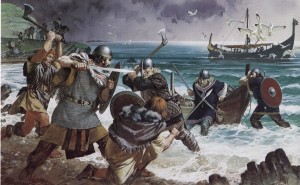
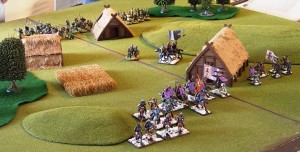
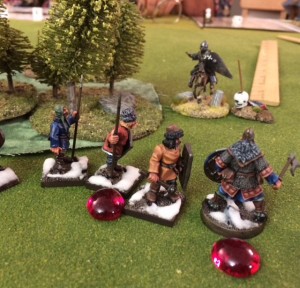
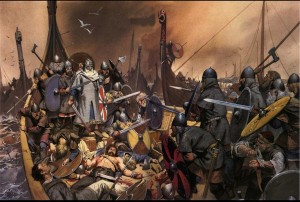
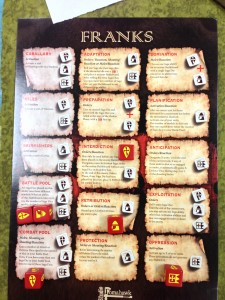
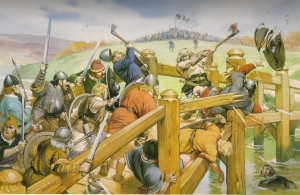
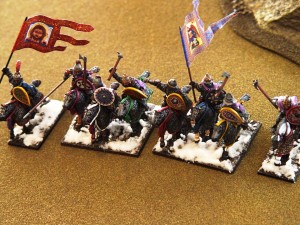



Tight, as always.
Thanks for this, Brinton. I fully agree with the alternate dice idea, but am totally onboard with the Full Merch approach.
Having [a copy of] your opponent’s board is clever and certainly should help you track and learn the game. Shades of Warmahordes here, where is advisable to learn what your opponent can do. (Or not, if you’re simply in in for the banter and inevitable mosh.)
Thanks, buddy.
Pingback: Saga Figure Showcase: Viking Age of Quarrel | COREHAMMER
Man Brinton, I love your writing style. I just stumbled across your blog while mindlessly ogling over beautifully painted minis. Your stuff is so much better then the rest of the grey haired historical wargames community who complain about there back pain. while your here making hilarious observations about about the clothing styles of the Dark ages (pants, no pants, horses, weirdos).
Keep putting out great stuff
Great article and even better laugh.
If only every games promo was written like this!
Any game which doesn’t require you to have the rule book on standby for every turn is a winner in my book.
Now to get my self a copy of SAGA.